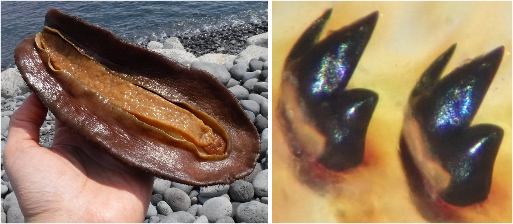Enlarge Image
Identification of the proteins governing the formation of “magnetic teeth” in chiton
Chiton deposit magnetite (Fe3O4) on their mineralized radular teeth.
In order to form the magnetite under physiological conditions, it was suggested that chitons might use biomolecules, such as proteins, to control oxidation / reduction of iron oxides. However, due to the lack of detailed molecular biological analysis of chitons, mechanisms of magnetite teeth formation are not clear.
Michiko Nemoto, Graduate School of Environmental and life Science Okayama University and David Kisailus, Department of Chemical and Environmental Engineering, University of California, Riverside report the first comprehensive gene inventory of gumboot chiton, Cryptochiton stelleri, providing a broad overview of magnetite teeth mineralization. Furthermore, their work identified several proteins that may be involved in magnetite formation.
To reveal the proteins involved in magnetite mineralization, RNA (transcription products) were extracted from radular tissue and sequenced using a next generation sequencing platform. As a result, a comprehensive gene inventory of radular tissue that consists of more than 100,000 genes was successfully developed. The gene inventory was also used for a proteomic analysis of radular teeth proteins.
This is the first report describing a comprehensive analysis of genes and proteins expressed in chiton that has magnetite teeth. Furthermore, this study successfully identified several proteins associated with magnetite teeth that may be involved in magnetite formation in chiton.
The results of this study pave the way for developing a low temperature, environmentally benign biological process to produce magnetite for a wide range of applications including magnetic recording, secondary battery, and MRI contrast agents.
Reference:
- Authors: Michiko Nemoto, Dongni Ren, Steven Herrera, Songqin Pan, Takashi Tamura, Kenji Inagaki and David Kisailus
- Title of original paper: Integrated transcriptomic and proteomic analyses of a molecular mechanism of radular teeth biomineralization in Cryptochiton stelleri
- Journal, volume, pages and year: Scientific Reports 9:856 (2019).
- Digital Object Identifier (DOI): 10.1038/s41598-018-37839-2
- Journal website: https://www.nature.com/articles/s41598-018-37839-2
- Affiliations: Graduate School of Environmental and life Science, Okayama University
- Department website:http://www.gels.okayama-u.ac.jp/index_e.html
- Okayama University Scientific Achievement Repository: http://ousar.lib.okayama-u.ac.jp/57012


